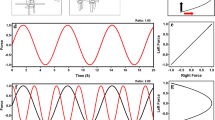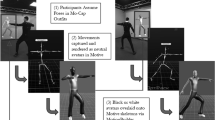Abstract
The current project evaluated the relationship between the stability of intrapersonal coordination and the emergence of spontaneous interpersonal coordination. Participants were organized into pairs, and each participant was instructed to produce either an inphase or antiphase pattern of intrapersonal bimanual coordination using two hand-held pendulums, while simultaneously performing an interpersonal puzzle task. At issue was whether the emergence and stability of spontaneous interpersonal rhythmic coordination is influenced by (“Experiment 1”) the stability of the intrapersonal coordination patterns produced by co-actors and (“Experiment 2”) the congruency of the intrapersonal coordination patterns produced by co-actors. The stability of intrapersonal movement coordination did not affect the emergence of spontaneous interpersonal coordination. The degree of interpersonal coordination observed was similar when both participants in a pair produced either inphase or antiphase patterns of intrapersonal bimanual coordination. Moreover, the congruency of the intrapersonal coordination patterns only slightly affected the emergence of interpersonal coordination, with only marginally lower inphase interpersonal entrainment when participants produced incongruent patterns of intrapersonal coordination (e.g., inphase–antiphase). Interestingly, movement observation and the emergence of interpersonal coordination did not affect the stability of intrapersonal bimanual coordination. The results suggest that interlimb rhythmic bimanual coordination reflects a single intrapersonal perceptual-motor synergy and that these bimanual synergies (not individual limbs) are what become spontaneously entrained interpersonally.



Similar content being viewed by others
References
Amazeen PG, Schmidt RC, Turvey MT (1995) Frequency detuning of the phase entrainment dynamics of visually coupled rhythmic movements. Biol Cybern 72:511–518
Black DP, Riley MA, McCord CK (2007) Synergies in intra- and interpersonal interlimb rhythmic coordination. Mot Control 11:348–373
Brass M, Bekkering H, Wohlschlager A, Prinz W (2000) Compatibility between observed and executed finger movements: Comparing symbolic, spatial, and imitative cues. Brain Cogn 44:124–143
Brass M, Bekkering H, Prinz W (2001) Movement observation affects movement execution in a simple response task. Acta Psychol 106:3–22
Fuchs A, Jirsa VK, Haken H, Kelso JAS (1996) Extending the HKB model of coordinated movement to oscillators with different eigenfrequencies. Biol Cybern 74:21–30
Haken H, Kelso JAS, Bunz H (1985) A theoretical model of phase transitions in human hand movements. Biol Cybern 51:347–356
Harrison SJ, Richardson MJ (2009) Horsing around: spontaneous four-legged coordination. J Mot Behav 41:519–524
Kelso JAS (1984) Phase transitions and critical behavior in human bimanual coordination. Am J Physiol Regul Integr Comp 246:R1000–R1004
Kelso JAS (1995) Dynamic patterns. Cambridge, MA
Kelso JAS, DelColle JD, Schöner G (1990) Action–perception as a pattern formation process. In: Jeannerod M (ed) Attention and performance XIII. Erlbaum, Hillsdale, pp 139–169
Kilner JM, Paulignan Y, Blakemore SJ (2003) An interference effect of observed biological movement on action. Curr Biol 13:522–525
Kugler PN, Turvey MT (1987) Information natural law and the self-assembly of rhythmic movement. Erlbaum, Hillsdale
Oullier O, de Guzman GC, Jantzen KJ, Lagrade J, Kelso JAS (2008) Social coordination dynamics: Measuring human bonding. Soc Neurosci 3:178–192
Richardson MJ, Marsh KL, Schmidt RC (2005) Effects of visual and verbal interaction on unintentional interpersonal coordination. J Exp Psychol Hum Percept Perform 31:62–79
Richardson MJ, Schmidt RC, Kay BA (2007a) Distinguishing the noise and attractor strength of coordinated limb movements using recurrence analysis. Biol Cybern 96:59–78
Richardson MJ, Marsh KL, Isenhower R, Goodman J, Schmidt RC (2007b) Rocking together: dynamics of intentional and unintentional interpersonal coordination. Hum Mov Sci 26:867–891
Richardson MJ, Campbell WL, Schmidt RC (2009) Movement interference during action observation as emergent coordination. Neurosci Lett 449:117–122
Riley MA, Santana MV, Turvey MT (2001) Deterministic variability and stability in detuned bimanual rhythmic coordination. Hum Mov Sci 20:343–369
Riley MA, Richardson MJ, Shockley K (2011) Interpersonal synergies. Front Mov Sci Sport Psychol 2:1–7
Rizzolatti G, Craighero L (2004) The mirror-neuron system. Annu Rev Neurosci 27:169–192
Schmidt RC, O’Brien B (1997) Evaluating the dynamics of unintended interpersonal coordination. Ecol Psychol 9:189–206
Schmidt RC, Richardson MJ (2008) Dynamics of Interpersonal Coordination. In: Fuchs A, Jirsa V (eds) Coordination: neural behavioral and social dynamics. Springer, Heidelberg, pp 281–308
Schmidt RC, Turvey MT (1994) Phase-entrainment dynamics of visually coupled rhythmic movements. Biol Cybern 70:369–376
Schmidt RC, Carello C, Turvey MT (1990) Phase transitions and critical fluctuations in the visual coordination of rhythmic movements between people. J Exp Psychol Hum Percept Perform 16:227–247
Schmidt RC, Shaw B, Turvey MT (1993) Coupling dynamics in interlimb coordination. J Exp Psychol Hum Percept Perform 19:397–415
Schmidt RC, Bienvenu M, Fitzpatrick PA, Amazeen PG (1998) A comparison of intra- and interpersonal interlimb coordination: coordination breakdowns and coupling strength. J Exp Psychol Hum Percept Perform 24:884–900
Schmidt RC, Fitzpatrick P, Caron R, Mergeche J (2010) Understanding social motor coordination. Hum Mov Sci. doi:10.1016/j.humov.2010.05.014
Schöner G, Haken H, Kelso JAS (1986) A stochastic theory of phase transitions in human hand movement. Biol Cybern 53:247–257
Sebanz N, Knoblich G (2009) Prediction in joint action: what, when, and where. Top Cogn Sci 1:353–367
Stanley J, Gowen E, Miall C (2007) Effects of agency on movement interference during observation of a moving dot stimulus. J Exp Psychol Hum Percept Perform 33:915–926
Sternad D, Collins D, Turvey MT (1995) The detuning factor in the dynamics of interlimb rhythmic coordination. Biol Cybern 73:27–35
Turvey M (1990) Coordination. Am Psychol 45:938–953
Van Ulzen NR, Lamoth CJC, Daffertshofer A, Semin GR, Beek PJ (2008) Characteristics of instructed and uninstructed interpersonal coordination while walking side-by-side. Neurosci Lett 432:88–93
Acknowledgments
This research was supported by the National Science Foundation (BCS Awards: 0750190, 0750187, 0926662) and SKILLS, an Integrated Project (FP6-IST contract #035005) of the Commission of the European Community. We would like to thank Kristen Thatcher and Jennifer Rutherford for help with data collection.
Author information
Authors and Affiliations
Corresponding author
Rights and permissions
About this article
Cite this article
Coey, C., Varlet, M., Schmidt, R.C. et al. Effects of movement stability and congruency on the emergence of spontaneous interpersonal coordination. Exp Brain Res 211, 483–493 (2011). https://doi.org/10.1007/s00221-011-2689-9
Received:
Accepted:
Published:
Issue Date:
DOI: https://doi.org/10.1007/s00221-011-2689-9




